Near the southeast corner of Wilkins Avenue and Caton Avenue in Baltimore, Maryland, is a four story stone building that once housed St. Mary’s Industrial School for Boys and, later, Cardinal Gibbons High School. There seems to be a general assumption that this building dates to the time that Babe Ruth attended St. Mary’s Industrial School for Boys (1902 – 1914) because it’s architecture is similar to buildings that once comprised the St. Mary’s Industrial School complex, but were destroyed by a fire at the school in 1919.
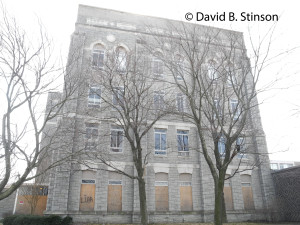
Four Story Stone Building Located On Former Site Of St. Mary’s Industrial School For Boys, Baltimore, Maryland
Below is an Xaverian Brothers’ photograph of St. Mary’s Industrial School, circa 1911, as it looked at the time Babe Ruth was a “student” there. The main administrative building complex, which included both dormitories and classrooms, fronted Wilkins Avenue. The St. Mary’s Industrial School Chapel, constructed in 1911, was located at the corner of Wilkins Avenue and Caton Avenue, and can be seen to the right of the photo as well. The separate dormitory and classroom building, which can be seen to the left of the photo, was constructed in 1909.
The main entrance to the complex included a six-story tower with a circular drive in front of the tower that was accessible from Wilkins Avenue.
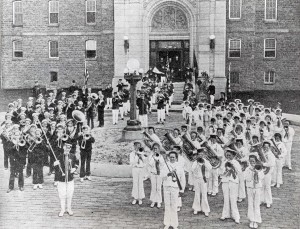
Front Entrance To St. Mary’s Industrial School In 1919, Before Fire That Destroyed The Building Later That Year (Baltimore Sun Photo)
The 1919 fire destroyed the main administrative building complex that fronted Wilkins Avenue, including the dormitory that was completed just ten years earlier. Although the stone walls of the dormitory and the building to the left of the front entrance appear to be somewhat intact even after the fire, it appears that the stone walls of the buildings located just to the right of the front entrance sustained considerably more damage. The chapel, which can be seen in the photo as well, sustained only smoke and water damage.
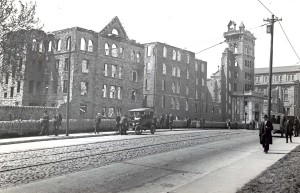
St. Mary’s Industrial School Looking Southeast Down Wilkins Avenue, After The 1919 Fire (Photo by Hildegarde Anderson of 3236 Ravenswood Avenue, Baltimore Sun Reprint of Hildegarde photo, 1962).
Soon after the fire, an effort was underway to rebuild the school. By 1923, the Xaverian Brothers had completed construction of the four story stone building which remains at the site today.
The four story building was constructed just east of the chapel. However, the chapel is no longer at the site, having been demolished in 1961 to make way for construction of Cardinal Gibbons High School.
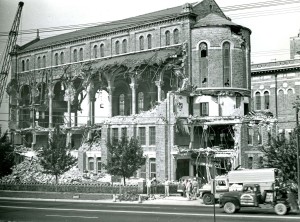
Demolition Of St. Mary’s Industrial School Chapel In 1961 (Baltimore Sun Photo, Ralph Robinson photographer)
So the question is, whether the four story stone building currently at the site was brand new as of 1923, or whether it predates the fire and was a renovation of a portion of the main administrative building complex not destroyed by the fire.
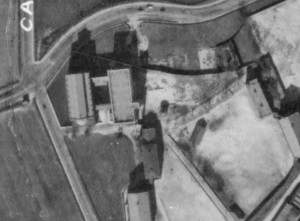
Aerial View Of St. Mary’s Circa 1927, Showing Chapel And Four Story Stone Building Fronting Wilkins Avenue – with the Chapel Located at the Corner of Caton Avenue and Wilkins Avenue (Maryland Port Administration Aerial Photo – image located at jscholarship.library.jhu.edu)
The answer to this mystery lies partially in the above 1927 aerial photo of the St. Mary’s Industrial School grounds, which shows the placement and location of the chapel and the four story stone building eight years after the fire. Both buildings front Wilkins Avenue (which runs east and west) and the chapel is located at the southeast corner of Wilkins Avenue and Caton Avenue (which runs north and south). Indeed, the chapel’s steeple can be seen in the shadow it casts over Wilkins Avenue. Given the placement of the circular drive (which is visible in the photo as well), the four story stone building at the site today sits just to the west of what would have been the front entrance of the original building complex. However, the front facade of the four story stone building at the site today – with its six columns of windows – does not match the facade of the building(s) that sat just to the west of the front entrance prior to the fire – each of which had four columns of windows.

Four Story Stone Building Located On Former Site Of St. Mary’s Industrial School For Boys, Baltimore, Maryland
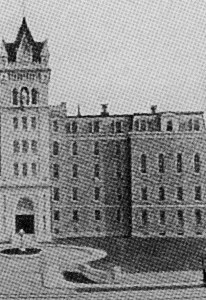
Detail of Xaverian Brothers Photo Of St. Mary’s Industrial School For Boys, Circa 1900, Before The 1919 Fire
Moreover, even assuming that the four story stone building at the site today predated the 1919 fire and somehow had survived the fire, that building would be evident in photo of the school taken just after the fire. Indeed, the building would have blocked the side view of the chapel in the photo below. However, the side view of the chapel – from front to back – is clearly visible in the 1919 photo of the fire damage.
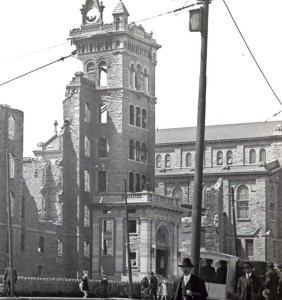
Detail of Photo Taken After The Fire (Photo by Hildegarde Anderson of 3236 Ravenswood Avenue, Baltimore Sun Reprint of Hildegarde photo, 1962).
Thus, it would appear that the four story stone building at the former site of St. Mary’s Industrial School today was new construction in 1923, and not a renovation of a building that was at the site during the time Babe Ruth attended the school. However, I am open to anyone who has any information that might shed additional light on this issue, or flat out knows the answer. If you do, just submit a comment!




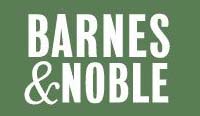

The entire former main school building was destroyed in the fire. The fire, started by tinners working on the roof using fire pots, killed three Baltimore City firefighters that were fighting the blaze. There was an archdiocesan effort, lead by then Archbishop of Baltimore, James Cardinal Gibbons, to raise money by appealing to the various parishes throughout the archdiocese for money. Babe Ruth, who was already playing professional baseball, and playing it well, I might add, took the all-boys school band from St. Mary’s on a tour of baseball parks so they could perform and pass the hat among the spectators. The cornerstone on the building that stands there today, and which replaced the building destroyed by fire in 1919, reads 1921. The chapel, which was torn down in the early 60’s when the archdiocese was reopening the shuttered St. Mary’s, which had closed in 1950, to open the new Cardinal Gibbons High School, made way for the new school’s auditorium. The majority of the stained glass windows from the old St. Mary’s chapel were installed in the St. Mark’s Church in Catonsville, MD. The Catholic education of boys began on that property once owned by Emily MacTavish, the granddaughter of Charles Carroll of Carrollton, the only Catholic signer of the Declaration of Independence, was initially leased and, upon her death, bequeathed to the Archdiocese of Baltimore, in 1866.
I agree David! Thank you for adding detail about the fire. I completely missed the cornerstone from 1921! I will look for it next time I am up that way.
As an aside, a couple years ago I found a Private Mailing Card from Brother Paul Scanlon, who was school superintendent at the time of the fire, that pictures the St. Mary’s Band near the baseball field where Ruth once played, thanking patrons for contributing funds for rebuilding the school. The card includes a note from Brother Paul dated March 3, 1921, thanking “Miss Cramer” for a one dollar donation. Brother Paul adds, “Shall have our little boys pray for your intention. May God bless you.” Brother Paul remained at St. Mary’s until 1925, and three years later was named Superior General of the Xaverian order. So much history at the corner of Wilkins Avenue and Caton Avenue! Here is more about that postcard:
https://davidbstinsonauthor.com/2016/02/27/babe-ruths-band-at-st-marys-industrial-school-for-boys/ DBS